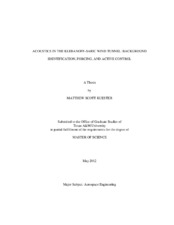| dc.contributor.advisor | White, Edward B. | |
| dc.creator | Kuester, Matthew | |
| dc.date.accessioned | 2012-07-16T15:57:33Z | |
| dc.date.accessioned | 2012-07-16T20:22:33Z | |
| dc.date.available | 2014-09-16T07:28:18Z | |
| dc.date.created | 2012-05 | |
| dc.date.issued | 2012-07-16 | |
| dc.date.submitted | May 2012 | |
| dc.identifier.uri | https://hdl.handle.net/1969.1/ETD-TAMU-2012-05-10731 | |
| dc.description.abstract | Low disturbance wind tunnels, such as the Klebanoff–Saric Wind Tunnel (KSWT), offer an ideal environment to study boundary layer transition. In particular, the leading-edge receptivity of sound can be measured by creating acoustic disturbances that interact with the leading edge of a model to create Tollmien–Schlichting Waves. The magnitude and composition (sound, turbulence) of the background disturbances can affect these experiments, so the background disturbances should be minimized and documented thoroughly.
The purpose of this thesis is to document the background acoustic signature of the KSWT and describe infrastructure upgrades for acoustic receptivity experiments. The measurements presented in this thesis will support future receptivity measurements in the KSWT.
Microphone measurements revealed several important acoustic features in the tunnel. Cross correlations showed that two sources of low-frequency unsteadiness (the extended diffuser and corner two) create large pressure fluctuations that dominate the pressure spectrum. Directional separation of waves in the test section revealed that motor and blade passing noise travels primarily upstream into the test section. Finally, the acoustic treatments in the plenum are effective at removing sound from the tunnel.
A wall of speakers was installed in the plenum to enable acoustic receptivity experiments. The speakers create both the primary downstream traveling waves and reflected upstream traveling waves in the test section. An adaptive closed loop control system was installed to reduce the amplitude of the reflected waves during acoustic forcing. Although the performance of the control system is frequency dependent, the technique was implemented successfully. The reduction in the diffuser reflection will increase the quality of future acoustic receptivity experiments in the KSWT. | en |
| dc.format.mimetype | application/pdf | |
| dc.language.iso | en_US | |
| dc.subject | Acoustics | en |
| dc.subject | Wind Tunnel | en |
| dc.subject | Boundary Layer Receptivity | en |
| dc.subject | Active Noise Control | en |
| dc.title | Acoustics in the Klebanoff-Saric Wind Tunnel: Background Identification, Forcing, and Active Control | en |
| dc.type | Thesis | en |
| thesis.degree.department | Aerospace Engineering | en |
| thesis.degree.discipline | Aerospace Engineering | en |
| thesis.degree.grantor | Texas A&M University | en |
| thesis.degree.name | Master of Science | en |
| thesis.degree.level | Masters | en |
| dc.contributor.committeeMember | Saric, William S. | |
| dc.contributor.committeeMember | Kim, Yong-Joe | |
| dc.type.genre | thesis | en |
| dc.type.material | text | en |
| local.embargo.terms | 2014-07-16 | |


